Felt
Felt is a textile material that is produced by matting, condensing and pressing fibers together. Felt can be made of natural fibers such as wool or animal fur, or from synthetic fibers such as petroleum-based acrylic or acrylonitrile or wood pulp-based rayon. Blended fibers are also common.[1][2][3] Felt has special properties that allow it to be used for a wide variety of purposes. "It is fire-retardant and self-extinguishing; it dampens vibration and absorbs sound; and it can hold large amounts of fluid without feeling wet..."[4]:10
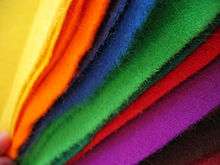

History
Felt from wool is considered to be the oldest known textile.[5] Many cultures have legends as to the origins of felt making. Sumerian legend claims that the secret of feltmaking was discovered by Urnamman of Lagash.[6] The story of Saint Clement and Saint Christopher relates that the men packed their sandals with wool to prevent blisters while fleeing from persecution. At the end of their journey, the movement and sweat had turned the wool into felt socks.[7][8]
Most likely felt's origins can be found in central Asia, where there is evidence of feltmaking in Siberia (Altai mountains) in Northern Mongolia and more recently evidence dating back to the first century AD in Mongolia. Siberian tombs (7th to 2nd century BC) show the broad uses of felt in that culture, including clothing, jewelry, wall hangings, and elaborate horse blankets. Employing careful color use, stitching, and other techniques, these feltmakers were able to use felt as an illustrative and decorative medium on which they could depict abstract designs and realistic scenes with great skill. Over time these makers became known for the beautiful abstract patterns they used that were derived from plant, animal, and other symbolic designs.[4]:21
From Siberia and Mongolia, feltmaking spread across the areas held by the Turkic-Mongolian tribes. Sheep and camel herds were central to the wealth and lifestyle of these tribes, both of which were critical to producing the fibers needed for felting. As nomads travelling frequently and living on fairly treeless plains, felt provided housing (yurts, tents, etc.), insulation, floor coverings, and inside walling, as well as many household necessities from bedding and coverings to clothing. In nomadic peoples, an area where feltmaking was particularly visible was in trappings for their animals and for travel. Felt was often featured in the blankets that went under saddles.[4]
Dyes provided rich coloring, and colored slices of pre-felts (semi-felted sheets that could be cut in decorative ways), along with dyed yarns and threads were combined to create beautiful designs on the wool backgrounds. Felt was even used to create totems and amulets with protective functions. In traditional societies, the patterns embedded in the felt were also imbued with significant religious and symbolic meaning.[4]:21–23
Feltmaking is still practised by nomadic peoples (such as Mongols and Turkic people) in Central Asia, where rugs, tents and clothing are regularly made.[9] Some of these are traditional items, such as the classic yurt (Gers),[10] while others are designed for the tourist market, such as decorated slippers.[11] In the Western world, felt is widely used as a medium for expression in both textile art and contemporary art[7] and design, where it has significance as an ecologically responsible textile and building material.[12]
In addition to Central Asian traditions of felting, Scandinavian countries have also supported feltmaking, particularly for clothing[13]
Manufacturing methods
Wet felting
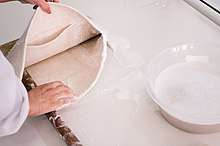
In the wet felting process, hot water is applied to layers of animal hairs, while repeated agitation and compression causes the fibers to hook together or weave together into a single piece of fabric.[14] Wrapping the properly arranged fiber in a sturdy, textured material, such as a bamboo mat or burlap, will speed up the felting process. The felted material may be finished by fulling.
Only certain types of fiber can be wet felted successfully. Most types of fleece, such as those taken from the alpaca or the Merino sheep,[15] can be put through the wet felting process. One may also use mohair (goat), angora (rabbit),[16] or hair from rodents such as beavers and muskrats.[17] These types of fiber are covered in tiny scales, similar to the scales found on a strand of human hair.[18] Heat, motion, and moisture of the fleece causes the scales to open, while agitating them causes them to latch onto each other, creating felt.[19][20] There is an alternative theory that the fibers wind around each other during felting.[21] Plant fibers and synthetic fibers will not wet felt.[22]
In order to make multi-colored designs, felters conduct a two-step process in which they create pre-felts of specialized colors—these semi-completed sheets of colored felt can then be cut with a sharp implement (knife or scissors) and the distinctive colors placed next to each other as in making a mosaic. The felting process is then resumed and the edges of the fabric attach to each other as the felting process is completed. Shrdak carpets (Turkmenistan) use a form of this method wherein two pieces of contrasting color are cut out with the same pattern, the cut-outs are then switched, fitting one into the other, which makes a sharply defined and colorful patterned piece. In order to strengthen the joints of a mosaic style felt, feltmakers often add a backing layer of fleece that is felted along with the other components. Feltmakers can differ in their orientation to this added layer—where some will lay it on top of the design before felting and others will place the design on top of the strengthening layer.[4]:29
The process of felting was adapted to the lifestyles of the different cultures in which it flourished. In Central Asia, it is common to conduct the rolling/friction process with the aid of a horse, donkey, or camel, which will pull the rolled felt until the process is complete. Alternately, a group of people in a line might roll the felt along, kicking it regularly with their feet. Further fulling can include throwing or slamming and working the edges with careful rolling.[4]:26In Turkey, some baths had areas dedicated to feltmaking, making use of the steam and hot water that were already present for bathing.[4]:37
Development of Felting as a Profession
As felting grew in importance to a society, so, too, did the knowledge about techniques and approaches. Amateur or community felting obviously continued in many communities at the same time that felting specialists and felting centers began to develop. However, the importance of felting to community life can be seen in the fact that, in many Central Asian communities, felt production, is directed by a leader who oversees the process as a ritual that includes prayers—words and actions to bring good luck to the process. Successfully completing the creation of felt (certainly large felt pieces) is reason for celebration, feasting, and the sharing of traditional stories.[4]:38–40
In Turkey, craft guilds called "ahi" came into being, and these groups were responsible for registering members and protecting the knowledge of felting. In Istanbul at one time, there were 1,000 felters working in 400 workshops registered in this ahi.:33[4]
Needle felting
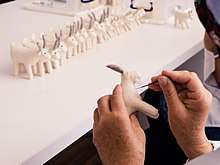
Needle felting is a method of creating felted objects without using water. The special needles used to make 3D sculpture, jewelry, adornments and 2D art have notches along the shaft of the needle that catch fibers and tangle them with other fibers to produce felt. These notches are sometimes erroneously called "barbs", but barbs are protrusions (like barbed wire) and would be too difficult to thrust into the wool and nearly impossible to pull out. There are many sizes and types of notched needles for different uses while working. Needle felting is used in industrial processes as well as in individual crafting.
Needles used for crafting are often very thin needles, sometimes fitted in holders that allow the user to utilize 2 or more needles at one time to sculpt wool objects and shapes. The single thin needles are used for detail and the multiple needles that are paired together are used for larger areas or to form the base of the project. At any point in time a variety of fiber colors may be added for detail and individuality, using needles to incorporate them into the project.
The kawaii style of needle felting was made popular by the Japanese culture. Kawaii means cute in Japanese and to felt in the kawaii style just means to make the object cute. Most kawaii needle felt sculptures have small, minimal detail, faces and are brightly colored. They are more cute and playful compared to the more traditional needle felt which is more rustic and earthy.[23][24][25] Ikuyo Fujita(藤田育代 Fujita Ikuyo)is a Japanese artist who works primarily in needle felt painting and mogol (pipe cleaner) art.
Needle felting can also be used to create realistic 3 dimensional animals. A wire armature can be created to help the process and provide support, around which a needle felted body and coat can be added. The art of needle felting is becoming very popular worldwide.
More recently, needle-felting or embellishment machines have become popular for art or craft felters. Similar to a sewing machine, these tools have several needles that punch fibers together as the user pushes fibers through in a manner very similar to feeding a sewing machine. The embellishment machine allows the user to create unique combinations of fibers and designs.[26]
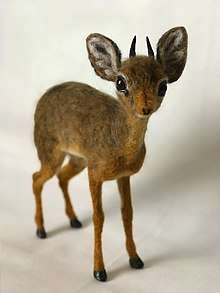


Carroting
Invented in the mid 17th century[27][28] and used until the mid-20th centuries, a process called "carroting" was used in the manufacture of good quality felt for making men's hats. Beaver, rabbit or hare skins were treated with a dilute solution of the mercury compound mercuric nitrate.[28] The skins were dried in an oven where the thin fur at the sides turned orange, the color of carrots.[27] Pelts were stretched over a bar in a cutting machine, and the skin was sliced off in thin shreds, with the fleece coming away entirely.[29] The fur was blown onto a cone-shaped colander and then treated with hot water to consolidate it.[30] The cone then peeled off and passed through wet rollers to cause the fur to felt. These 'hoods' were then dyed and blocked to make hats. The toxic solutions from the carrot and the vapours it produced resulted in widespread cases of mercury poisoning among hatters.[27] This may be the origin of the phrase "mad as a hatter" which was used to humorous effect by Lewis Carroll in the chapter "A Mad Tea Party" of the novel Alice in Wonderland.
Uses
Felt is used in a wide range of industries and manufacturing processes, from the automotive industry and casinos to musical instruments and home construction, as well as in gun wadding, either inside cartridges or pushed down the barrel of a muzzleloader.
Felt in musical instruments
Many musical instruments use felt. It is often used as a damper.[32] On drum cymbal stands, it protects the cymbal from cracking and ensures a clean sound. It is used to wrap bass drum strikers and timpani mallets.[33] Felt is used extensively in pianos; for example, piano hammers are made of wool felt around a wooden core. The density and springiness of the felt is a major part of what creates a piano's tone.[34][35] As the felt becomes grooved and "packed" with use and age, the tone suffers.[36] Felt is placed under the piano keys on accordions to control touch and key noise; it is also used on the pallets to silence notes not sounded by preventing air flow.[37][38][39]
Industrial uses
Felt is frequently used in industry as a sound or vibration damper,[40] as a non-woven fabric for air filtration, and in machinery for cushioning and padding moving parts.[41]
Felt in arts and crafts
Felt is used for framing paintings. It is laid between the slip mount and picture as a protective measure to avoid damage from rubbing to the edge of the painting. This is commonly found as a preventive measure on paintings which have already been restored or professionally framed. It is widely used to protect paintings executed on various surfaces including canvas, wood panel and copper plate.
A felt-covered board can be used in storytelling to small children. Small felt cutouts or figures of animals, people, or other objects will adhere to a felt board, and in the process of telling the story, the storyteller also acts it out on the board with the animals or people. Puppets can also be made with felt. The best known example of felt puppets are Jim Henson's Muppets. Felt pressed dolls, such as Lenci dolls, were very popular in the nineteenth century and just after the first world war.
Felt in fashion
During the 18th and 19th centuries gentlemen's top hats made from beaver felt were popular.[29][42][43] In the early part of the 20th century, cloth felt hats, such as fedoras, trilbies[44] and homburgs,[45] were worn by many men in the western world. Felt is often used in footwear as boot liners, with the Russian valenki being an example.[46][47]
Modern Felt Renewal: Integrating Art and Craft
As part of the overall renewal of interest in textile and fiber arts, beginning in the 1970s and continuing through today, felt has experienced a strong revival in interest. In the U.K., Mary Burkett's book and exhibition (The Art of the Feltmaker, 1979) introduced new audiences to this old craft. This led to renewed interest in the historical roots of feltmaking, including the diverse traditions of the craft, from Mongolia to Japan, and North Africa to Europe. Artistic innovator's in this early period included Beth Beede, Inge Bauer, Polly Stirling, and Joan Livingstone.[4][48][49] Stirling is commonly associated with the development of nuno felting, a key technique for contemporary art felting[13]
An international infrastructure emerged to support this widening circle of felting enthusiasts that included many kinds of entrepreneurs from those who raised sheep to those who did bulk preparation of fibers. New organizations to support felters sprang up, as well as conferences, and books devoted to guiding new comers. There is now an International Feltmakers Association with headquarters in the UK, which publishes its own journal, Felt Matters. Annual gatherings such as Felters Fling or Felter's Rendezvous, among others, provide special opportunities for newcomers and experienced felters to interact around the topic. Moreover, arts organization with parallel or intersecting interests, such as the Surface Design Association, also provide support or inspiration to felters seeking community.
Fashioning Felt, an international exhibition held at the Cooper-Hewitt Museum in New York City (March 6-September 7, 2009), was an important moment in the recognition of both the artistic and practical elements of modern felt.[4] It provided new audiences with the opportunity to learn about the historical and contemporary techniques for the production of felt and information on the use of felt in art and industry.
Art felters today represent a broad continuum of work—some of which is closely related to the production of practical items such as wall coverings, clothing, hats, and shoes to those who exploit the qualities of felt in the creation of purely abstract pieces of work. For instance, Dutch felter Claudy Jongstra produced artistic felt that lines the walls of the Central Library in Amsterdam, are featured in the state home of the Dutch president, and are found in many corporate headquarters.[4][50] Felt lends itself well to the production of unique clothing design, either seamless (felted around templates) or seamed (cut and sewn like woven fabric). Francoise Hoffman in France, Catherine O'Leary in Australia,[51] Liz Clay in the UK,[52] are examples of felters who have championed the striking use of hybrid felts or nuno felt.[4][52][51] Hybrid felts are created from fleece, in which other fabrics, particularly silk but also woven textiles such as cotton, wool, and other materials with some porosity, are felted into one, connected through the barbules or scales on the fleece. Jori Johnson, an American working in Japan, even demonstrated the integration of felt with lacquer work.[4][53][54][13] Andrea Grahame [13] and Lisa Klakulak have used the unique features of felt and its shrinkage in the production of jewelry and sculptural pieces.[48] Mehmet Girgic, trained in traditional Turkish felting techniques was named one of Turkey's seven Living Treasures in 2010 by UNESCO and the Turkish Ministry of Culture and Tourism. Working with American Teresa May O'Brien, he has produced work that crosses approaches to felting with ancient practices. Girgic is the last remaining felter allowed to repair the felted hats of the whirling dervishes.[48][55][13]
Modern day felters with access to a broad range of sheep and other animal fibers have exploited knowledge of these different breeds to produce special effects in their felt. Fleece locks are classified by the Bradford or Micron count, both which designate the fineness to coarseness of the material. Fine wools range from 64 to 80 (Bradford); medium 40-60 (Bradford); and coarse 36-60 (Bradford).[13] Merino, the finest and most delicate sheep fleece, will be employed for clothing that goes next to the body, such as in the dresses designed by Andrea Zittel[4]:51 Claudy Jongstra raises traditional and rare breeds of sheep with much hardier coats (Drenthe, Heath, Gotland, Schoonbeek, and Wensleydale) on her property in Friesland and these are used in her many interior design projects[4]:53 Exploitation of these characteristics of the fleece in tandem with the use of other techniques, such as stitching, incorporation of other fibers, etc. provides felters with a broad range of possibilities[56]
Others, such as German artist Josef Beuys, prominently integrate felt within their works.[7][57] Another example is the English artist Jenny Cowern, who shifted from traditional drawing and painting media into using felt as her primary media[58]
Today, felters continue to push the boundaries of the material and its incorporation in new works that respond to developments in art and the sciences.
See also
- Bowler hat
- Fuzzy felt
- Nuno felting
- Joseph Beuys
- Roofing felt
- Valenki
References
- "What's the difference between wool, acrylic, wool blend, and eco felt? Part 1 Wool". 31 March 2009.
- "Acrylic felt & eco- felt (I.E eco spun) same damn thing! Part 2 of whats the difference between wool, acrylic, wool blend, and eco felt?". 1 April 2009.
- "Wool Felt Blends- part 3 of Whats the difference between wool, acrylic, wool blend, and eco felt?". 4 April 2009.
- Brown, Susan (2009). Fashioning Felt. New York City: Smithsonian, Cooper-Hewitt, National Design Museum. ISBN 978-0-910503-89-1.
- Chad Alice Hagen (2005). Fabulous Felt Hats: Dazzling Designs from Handmade Felt. Lark Books. pp. 8–. ISBN 978-1-57990-542-2.
- Dan Howard (2011). Bronze Age Military Equipment. Casemate Publishers. pp. 69–. ISBN 978-1-84884-293-9.
- Chris Thompson (2011). Felt: Fluxus, Joseph Beuys, and the Dalai Lama. U of Minnesota Press. pp. 56–. ISBN 978-0-8166-5354-6.
- The Recent Development of American Industries. University of Pennsylvania Press. 1891. pp. 63–.
- Melvyn C. Goldstein; Cynthia M. Beall (1994). The Changing World of Mongolia's Nomads. University of California Press. pp. 147–. ISBN 978-0-520-08551-0.
- Becky Kemery (2006). Yurts: Living in the Round. Gibbs Smith. pp. 160–. ISBN 978-1-58685-891-9.
- Front Lines. U.S. Agency for International Development. 2006.
- Maria Block; Varis Bokalders (9 February 2010). The Whole Building Handbook: "How to Design Healthy, Efficient and Sustainable Buildings". Routledge. pp. 57–. ISBN 978-1-136-54328-9.
- White, Christine (2007). Uniquely felt : dozens of techniques from fulling and shaping to nuno and cobweb : includes 46 creative projects. North Adams, MA: Storey Pub. ISBN 978-1-58017-673-6. OCLC 141188054.
- Forestry Leaves. 1963.
- Sabine Fouchier (12 February 2009). Felt. A&C Black. pp. 9–. ISBN 978-0-7136-8494-0.
- Teachers World. Bemis Publishing Company. 1893. pp. 219–.
- O. J. Petrie (1995). Harvesting of Textile Animal Fibres. Food & Agriculture Org. pp. 19–. ISBN 978-92-5-103759-1.
- The Chemical News. Mitchell. 1860. pp. 257–.
- Sarah E. White (1 January 2008). Picture Yourself Felting Your Knitting: Step-by-step Instruction for Perfectly Felted Crafts. Course Technology. pp. 10–. ISBN 978-1-59863-665-9.
- Krishan Chawla (2 June 2016). Fibrous Materials. Cambridge University Press. pp. 24–. ISBN 978-1-107-02972-9.
- T. C. Archer (1871). "Wool: Its Industrial Applications". The Technical Educator: An Encyclopædia of Technical Education. pp. 65–.
- Andrea Price; Patti Pierce Stone (13 September 2011). Knitspeak: An A to Z Guide to the Language of Knitting Patterns. STC Craft, Melanie Falick Books. pp. 76–. ISBN 978-1-4532-2078-8.
- “Everything You Need to Know to Start Needle Felting.” Wunderlabel, 22 Aug. 2017, wunderlabel.com/blog/everything-need-know-start-needle-felting.
- Alicia Kennedy; Emily Banis Stoehrer; Jay Calderin (1 February 2013). Fashion Design, Referenced: A Visual Guide to the History, Language, and Practice of Fashion. Rockport Publishers. pp. 153–. ISBN 978-1-59253-677-1.
- Wonderful West Virginia. Department of Natural Resources. 2005.
- Smith, Sheila (2008). Embellish, stitch, felt : using the embellisher machine and needle-punch techniques. London: Batsford. ISBN 978-1-906388-05-8. OCLC 227279237.
- Jack Larkin (23 November 2010). Where We Worked: A Celebration Of America's Workers And The Nation They Built. Lyons Press. pp. 95–. ISBN 978-1-4617-4592-1.
- Mary Ellen Snodgrass (17 March 2015). World Clothing and Fashion: An Encyclopedia of History, Culture, and Social Influence. Routledge. pp. 251–. ISBN 978-1-317-45167-9.
- Beverly Chico (3 October 2013). Hats and Headwear around the World: A Cultural Encyclopedia: A Cultural Encyclopedia. ABC-CLIO. pp. 309–. ISBN 978-1-61069-063-8.
- Bonnier Corporation (November 1941). Popular Science. Bonnier Corporation. pp. 52–. ISSN 0161-7370.
- Cooper-Hewitt museum description of Mosen rug.
- Ethan Winer (12 November 2012). The Audio Expert: Everything You Need to Know About Audio. CRC Press. pp. 629–. ISBN 978-1-136-12614-7.
- Hugo Pinksterboer (1 January 1993). The Cymbal Book. Hal Leonard. pp. 88–. ISBN 978-1-4768-6639-0.
- Steven L. Schweizer (28 June 2010). Timpani Tone and the Interpretation of Baroque and Classical Music. Oxford University Press. pp. 13–. ISBN 978-0-19-975041-2.
- Nicholas J. Giordano (8 September 2016). Physics of the Piano. OUP Oxford. pp. 113–. ISBN 978-0-19-250663-4.
- Robert Palmieri (1 June 2004). The Piano: An Encyclopedia. Routledge. pp. 161–. ISBN 978-1-135-94964-8.
- David C Wickens (1 December 1987). The Instruments of Samuel Green. Palgrave Macmillan UK. pp. 44–. ISBN 978-1-349-09059-4.
- Arthur W. J. G. Ord-Hume (1978). Barrel organ: the story of the mechanical organ and its repair. A. S. Barnes, Incorporated. ISBN 978-0-498-01482-6.
- Thomas Campbell Young (1947). The Making of Musical Instruments. Oxford University Press.
- Deborah Schneiderman; Alexa Griffith Winton (28 January 2016). Textile Technology and Design: From Interior Space to Outer Space. Bloomsbury Publishing. pp. 48–. ISBN 978-1-4742-6196-8.
- Beverly Gordon (May 1980). Feltmaking. Watson-Guptill Publications.
- Dietland Muller-Schwarze (7 April 2011). The Beaver: Its Life and Impact. Cornell University Press. pp. 156–. ISBN 978-0-8014-5010-5.
- Eric Jay Dolin (5 July 2011). Fur, Fortune, and Empire: The Epic History of the Fur Trade in America. W. W. Norton. pp. 22–. ISBN 978-0-393-34002-0.
- Bernard A. Drew (22 December 2009). Literary Afterlife: The Posthumous Continuations of 325 Authors' Fictional Characters. McFarland. pp. 45–. ISBN 978-0-7864-5721-2.
- Brenda Grantland (1 June 2016). Hatatorium: An Essential Guide for Hat Collectors. Brenda Grantland. pp. 76–. ISBN 978-0-9847859-0-2.
- Russian Winter: Photo album. Russia Beyond The Headlines. 12 December 2014. pp. 91–. GGKEY:G7NRFZX3WQF.
- Symposium on Antarctic Logistics, Held at Boulder, Colorado, August 13-17, 1962. National Academies. 1963. pp. 637–. NAP:12264.
- Cypher, Carol Huber (2007). How we felt : designs + techniques from contemporary felt artists. Loveland, CO: Interweave Press. ISBN 978-1-59668-031-9. OCLC 82673616.
- Bauer, Inge (2010). An-Gewand-t : ein Galeriebuch ; Filzimpressionen = Felted. Augsburg: MaroVerl. ISBN 978-3-87512-757-7. OCLC 612305258.
- Jongstra, Claudy (2005). Claudy Jongstra : matter and meaning. Lauwen, Toon. Amsterdam: Artimo. ISBN 90-8546-040-9. OCLC 64451730.
- O'Leary, Catherine (2011). From felt to fabric : new techniques in nuno felting. Lark Crafts (Firm) (1st ed.). New York: Lark Crafts. ISBN 978-1-60059-667-4. OCLC 700729253.
- Clay, Liz (2007). Nuno felt : techniques and inspiration for accessories and home interiors. London: A. & C. Black. ISBN 978-0-7136-8601-2. OCLC 163616688.
- Johnson, Jorie (2006). Felt making and wool magic : contemporary techniques and beautiful projects. Gloucester, Mass.: Quarry. ISBN 1-59253-275-6. OCLC 63186669.
- Hagen, Chad Alice (2007). Fabulous felted scarves : 20 wearable works of art. Johnson, Jorie. (1st ed.). New York: Lark Books. ISBN 978-1-60059-002-3. OCLC 86117611.
- "Felt in Turkey- case study Mehmet Girgiç". textiles of istanbul (in Dutch). 2011-11-16. Retrieved 2020-01-03.
- Tellier-Loumagne, Françoise (2008). The art of felt : inspirational designs, textures and surfaces. London: Thames & Hudson. ISBN 978-0-500-28731-6. OCLC 181139879.
- Joseph Beuys; Volker Harlan (2004). What is Art?: Conversation with Joseph Beuys. CLAIRVIEW BOOKS. pp. 65–. ISBN 978-1-905570-07-2.
- Rickerby, Valerie; Burkett, Mary (2007). A Softer Landscape: The Life and Work of Jenny Cowern. Skiddaw Press. ISBN 978-0-9528356-7-7.
Bibliography
- E.J.W. Barber. Prehistoric Textiles: The Development of Cloth in the Neolithic and Bronze Ages, with Special Reference to the Aegean. Princeton: Princeton University Press, 1991.
- Lise Bender Jørgensen. North European Textiles until AD 1000. Aarchus: Aarchus University Press, 1992.
External links

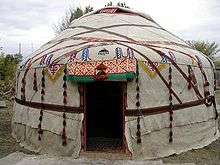
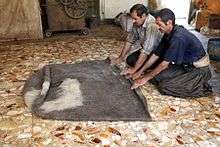
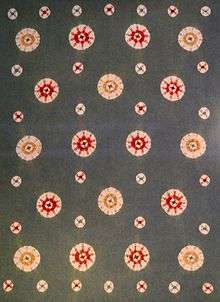
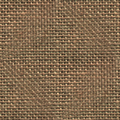
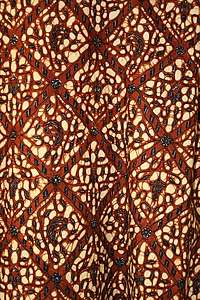
.svg.png)